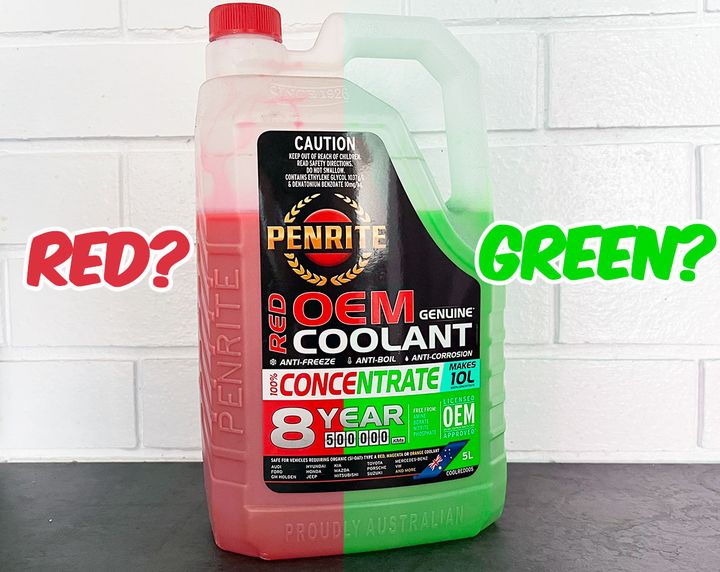


The simple answer is no – mixing red and green coolants in your vehicle's cooling system can lead to severe consequences and potential engine damage. This article will provide a comprehensive understanding of coolant types, their compatibility, and the importance of proper coolant maintenance.

A vehicle's cooling system plays a vital role in regulating engine temperature and preventing overheating. The coolant, a specialized fluid, is designed to absorb and transfer heat away from the engine components. However, using the wrong coolant type or mixing incompatible coolants can have detrimental effects on your vehicle's performance and longevity.
In this article, we will explore the differences between Organic Acid Technology (OAT) and Inorganic Additive Technology (IAT) coolants, commonly known as red and green coolants, respectively. We will examine the consequences of mixing these incompatible coolants, the potential risks to your cooling system, and the importance of following manufacturer recommendations for proper coolant maintenance.
Coolants are formulated with different chemistries and additives, which determine their compatibility and corrosion protection capabilities. The two main types of coolants are:
| Coolant Type | Color | Chemistry | Compatibility |
|---|---|---|---|
| OAT Coolants | Red or Orange | Organic Acids | Compatible with OAT coolants only |
| IAT Coolants | Green | Inorganic Salts and Phosphates | Compatible with IAT coolants only |
OAT coolants are designed to provide long-lasting protection against corrosion and are often recommended for newer vehicles with aluminum engine components. In contrast, IAT coolants offer effective corrosion protection for traditional materials but may not be suitable for modern engines with aluminum components.
Mixing OAT and IAT coolants can lead to severe consequences for your cooling system:
Chemical Reactions and Gel Formation: When these coolants are mixed, a chemical reaction occurs between the organic acids and inorganic salts, forming a gel-like or sludgy substance.
Cooling System Clogging: This gel-like substance can accumulate and clog various components of the cooling system, such as the radiator, water pump, and heater core, impeding coolant flow and reducing heat transfer efficiency.
Reduced Corrosion Protection: The corrosion inhibitors in the mixed coolants can become ineffective or neutralize each other, leading to accelerated corrosion of engine components.
Shortened Coolant Lifespan: The chemical reaction between the different coolant types can cause the coolant to degrade more rapidly, requiring more frequent flushes and replacements.
Overheating and Leaks: Clogging, reduced heat transfer, and corrosion can ultimately lead to overheating and coolant leaks, potentially causing severe engine damage.
To avoid the risks associated with mixing incompatible coolants, it is crucial to follow these guidelines:
Use the coolant type recommended by your vehicle's manufacturer, as specified in the owner's manual.
Follow the recommended maintenance schedule for regular coolant flushes and replacements.
If you suspect any issues with your cooling system or have accidentally mixed incompatible coolants, seek professional consultation and service immediately.
| Maintenance Task | Importance |
|---|---|
| Using Recommended Coolant Type | Ensures compatibility with cooling system components |
| Regular Coolant Flushes | Removes contaminants and replenishes additives |
| Coolant Replacements | Maintains optimal coolant performance and protection |
| Professional Consultation | Ensures proper diagnosis and repair of cooling system issues |
Mixing red and green coolants, or any incompatible coolant types, can have severe consequences for your vehicle's cooling system. To ensure longevity and proper functioning, it is essential to use the recommended coolant type and follow regular maintenance schedules. If you suspect any issues or have accidentally mixed incompatible coolants, seek professional assistance promptly to avoid further damage and costly repairs.
By understanding the importance of coolant compatibility and proper maintenance, you can protect your vehicle's cooling system and prevent potential engine failures down the line.
A chemical reaction occurs, forming a gel-like substance that can clog the cooling system and reduce corrosion protection. This can lead to overheating, leaks, and potential engine damage.
No, red (OAT) and green (IAT) coolants are not compatible due to their different chemistries. Mixing them can cause severe issues and should be avoided.
Using the wrong coolant type can lead to reduced corrosion protection, cooling system clogging, shortened coolant lifespan, overheating, and potential engine damage.
Coolant should be flushed and replaced according to the manufacturer's recommended maintenance schedule, typically every 30,000 to 60,000 miles or 2 to 5 years.
Yes, mixing incompatible coolants can potentially void the vehicle's warranty, as it goes against the manufacturer's recommendations and can cause damage to the cooling system.
If you accidentally mix incompatible coolants, seek professional assistance immediately to have the cooling system flushed and refilled with the correct coolant type.
The coolant type can be identified by checking the owner's manual or consulting with a professional mechanic. The color (red/orange or green) can also provide an indication.
No, there are generally no exceptions where mixing different coolant types is acceptable. It is always recommended to use the coolant type specified by the manufacturer.
Yes, coolant compatibility can affect older and newer vehicles differently due to changes in engine materials and cooling system designs over time.
Signs of a cooling system issue include overheating, coolant leaks, reduced cooling performance, and the presence of a gel-like or sludgy substance in the coolant.

Miguel started tinkering with car radios as a teenager, fascinated by the intricate dance of wires and circuits. This passion led him to pursue a career as an automotive electrician. For the past 10 years, Miguel has tackled everything from flickering headlights to mysterious electrical gremlins. He thrives on troubleshooting electrical problems and enjoys sharing his knowledge to empower car owners to understand their vehicles better.













